Discovering ancient Roman ruins in Europe is a wondeful way to journey back in time. At its largest in 117 AD under Emperor Trajan, the empire stretched 5 million km2. Today, travelers can visit temples, theaters, intricate mosaics, baths, and more to learn more of the stories of the Roman empire, conquest, and civilization. Some of these are in the centers of large cities; others will require some more effort to get to. Here is a collection of must-see Roman ruins across Europe, with tips on how to make the most of your visit.
This post may contain affiliate links. If you make a purchase through these links, we will earn a small commission at no additional cost to you. We recommend products we have personally used or verified. Read the full disclosure here.
If you don’t have time to read this now, pin it for later!

What to Read Before You Visit Europe’s Roman Ruins
Before embarking on your journey to explore Roman ruins across Europe, immerse yourself in the history and culture of the Roman Empire to enhance your experience. A highly recommended resource is The Penguin Historical Atlas of Ancient Rome, which provides a comprehensive overview of the empire’s rise and fall, complete with maps, timelines, and key historical insights. This book helps you visualize the vast network of Roman roads, cities, and territories, offering context for the ruins you’ll visit. For a deeper dive into Roman daily life, consider SPQR: A History of Ancient Rome by Mary Beard, which vividly recounts the empire’s social and political landscape.

Roman Ruins in Europe Highlights:
Top Roman Ruins in Europe: Albania
1. Butrint – UNESCO World Heritage Site
Butrint is an ancient Roman settlement surrounded by marshland in the south of Albania, dating back over 2,500 years. The UNESCO World Heritage Site consists of buried, ruined and perfectly preserved structures from Greek, Roman, Byzantine, and Venetian times. After the arrival of the Roman Empire in 44BC, the city was reconstructed by Julius Caesar who ordered the city to be turned into a Roman colony featuring temples, fountains, bath houses, mosaics and an aqueduct. The port city was then later abandoned in the Middle Ages by the Ottoman Empire when the nearby water levels started to rise.
Located just a one hour bus journey from Saranda, buses to Butrint leave every hour from the city and cost 150 lek per person each way. Entrance tickets cost 1000 lek and can be paid with either cash or card at the entrance, or online in advance. Once you enter, grab a map, and you can follow the clearly marked 2- 3 hour trail around the ruined walled city. Make sure to visit the castle, floor mosaic, and museum.
Butrint is open all year round but it’s recommended to visit in the spring and autumn due to the smaller crowds. However, don’t worry if visiting in July or August as the site is mostly shaded, protecting visitors from the summer sun. The closest place to stay is in the beach town of Ksamil. Stay in Hotel Meta Ksamil for modern well equipped rooms only a 30 minute bus journey away from Butrint.
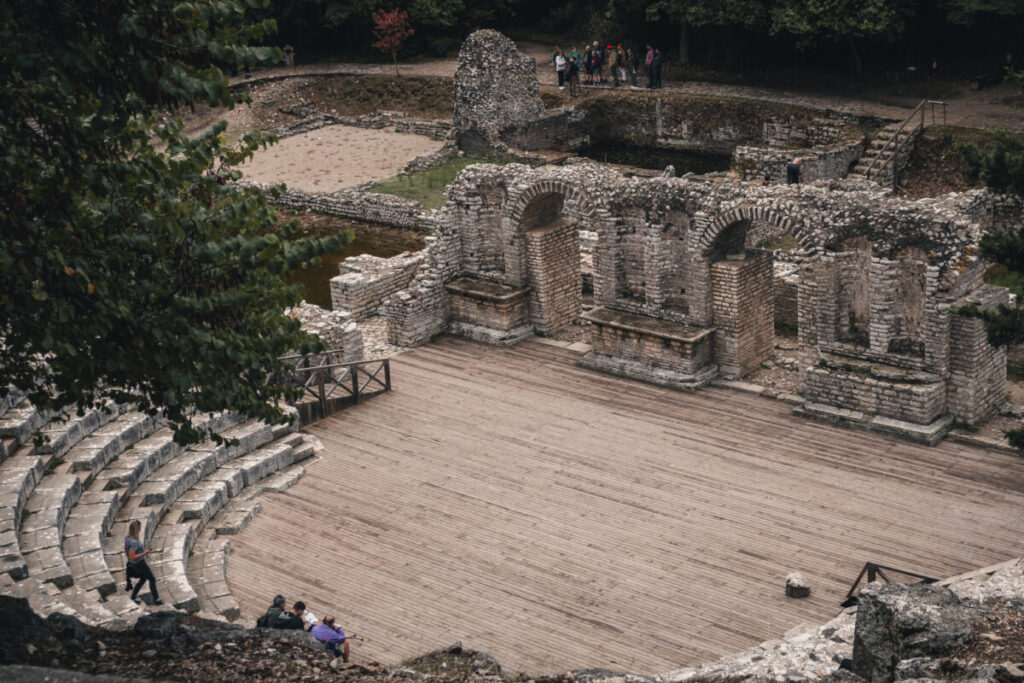
Top Roman Ruins in Europe: Croatia
2. Split – Diocletian’s Palace
Built in the 4th century AD by Emperor Diocletian as a lavish retirement residence, Diocletian’s Palace is a UNESCO World Heritage Site and a living part of Split’s old town. The palace complex includes well-preserved Roman architecture, such as the Peristyle courtyard, the Temple of Jupiter, and the emperor’s mausoleum, now the Cathedral of Saint Domnius.
Diocletian’s Palace is centrally located in Split, so is accessible on foot. It is free to roam through the streets of the palace, though there is an admission fee for any museums in the palace, the cathedral, and the bell tower. The best times to visit are early in the morning or around sunset, when the streets tend to be less crowded. Off-season is a great time to visit Split while avoiding the crowds.
Stay at Hotel Vestibul Palace & Villa if you are looking for a luxury, historical stay within Diocletian’s Palace.
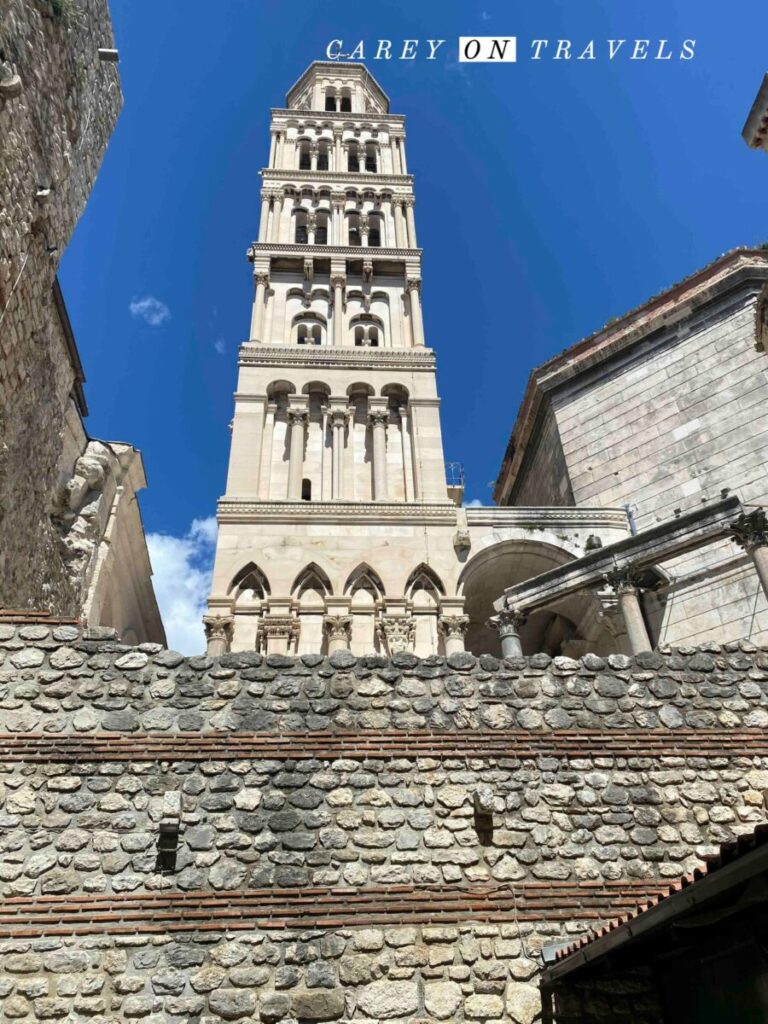
Top Roman Ruins in Europe: Cyprus
3. Nea Paphos – Kato Paphos Archaeological Park
Cyprus is renowned for its stunning beaches and mild winters, but what many people don’t know is that it is also home to significant Roman ruins. Located on the southern coast, the Archaeological Site of Nea Paphos is one of the most important historical sites in Cyprus and is recognized as a UNESCO World Heritage site.
Founded in 300 BC as the capital of Cyprus during the Hellenistic period, Nea Paphos also flourished under Roman rule from 58 BC until the 7th century AD. During this time, it became a key cultural, political, and religious centre. The city featured an impressive central market square, public baths, various temples, and a small Roman theatre, the Odeon, which was used for cultural performances and gatherings. The most famous part of the site is the House of Dionysos, renowned for its incredibly well-preserved mosaic floors depicting scenes from Greek and Roman mythology.
The ruins of Nea Paphos are located near the city’s marina, and the entrance fee to the park is €4.50. A public bus connects nearby hotels to the site, but if you’re staying outside of Paphos, renting a car is recommended. The best time to visit is early in the morning to avoid both the crowds and the midday heat.
If you’re looking for nearby accommodation, the Regency Boutique Hotel, located close to the marina, is an excellent option.
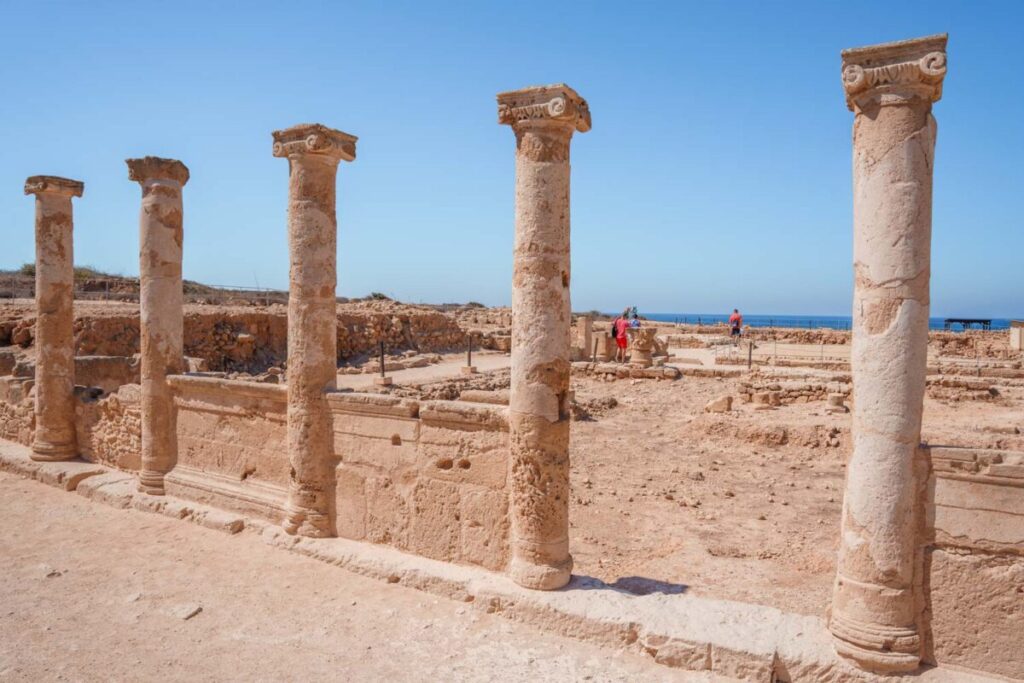
Top Roman Ruins in Europe: France
4. Lyons – Roman Theaters
Lyon France has some of the most well-preserved Roman ruins in Europe. Lyon was the capital of part of the Roman Empire, known as Gaul, and a major hub for trade and commerce during those 500 years. Back then, the city was called Lugdunum – also the name of the museum highlighting the city’s history. The museum has both indoor exhibitions as well as outdoor attractions, including several theaters, baths, and an ancient church.
We recommend taking one of the guided tours of the museums and outdoor theaters. Museum ticket prices will vary based on the temporary exhibitions scheduled, during the exhibitions, the price is €7. Otherwise, tickets cost €4. The museum is closed January 1st, May 1st, and December 25th.
The best way to access the Lugdunum Museum is to take the funicular up Fourviere Hill and walk the 1/4 mile down to the entry. The best time to visit is during the summer months when the theaters are open later and when there are organized musical performances and events, like the Nuits de Fourviere. The Best Western Hotel Pont du Wilson is a great nearby hotel, located across the river from the Fourviere Hill and Lugdunum Museum.
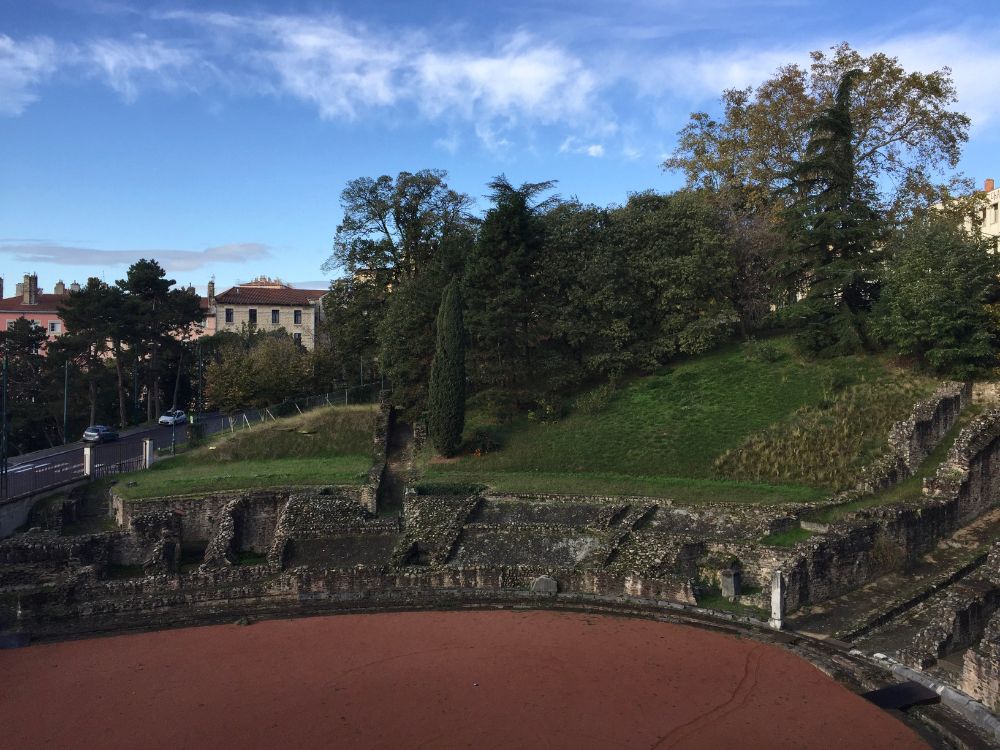
5. Nîmes – Maison Carrée and Amphitheatre
Nîmes, France is definitely one of the best places in Europe to see Roman ruins. It’s a treasure trove for Roman history buffs, and its small size makes it easy to explore on foot. One of the top things to do in Nimes is to explore the stunning Roman amphitheater, which dates from the 1st century AD. This arena is one of the most well-preserved, and your visit is enhanced by a downloadable audio guide. One of the unique Roman ruins in Nimes is the Maison Carrée, which was recently honored with a World Heritage Site designation.
The third Roman site of note is the Tour Magne. This tower was once part of the city’s defenses, and you can climb to the top to look out over the countryside. In addition to the Roman ruins, Nimes also has a top-notch Roman history museum, the Musée de la Romanité. This museum will transport you back to Roman times with fabulous mosaics and artifacts. While in Nîmes, don’t miss a side trip to see the incredible Roman bridge, Port du Gard.
Tip: If you plan to visit all of the Roman ruins in Nimes, be sure to purchase the Pass Romanité. The €19 full price ticket lets you visit the arena, temple, and tower, as well as the Roman history museum. Summer is the most popular time to visit Nimes. For a more memorable stay, plan your visit in May or September to align with the Féria festivals.
Stay at the 4-star Margaret – Hôtel Chouleur, with its the perfect location midway between the arena and the Maison Carrée.
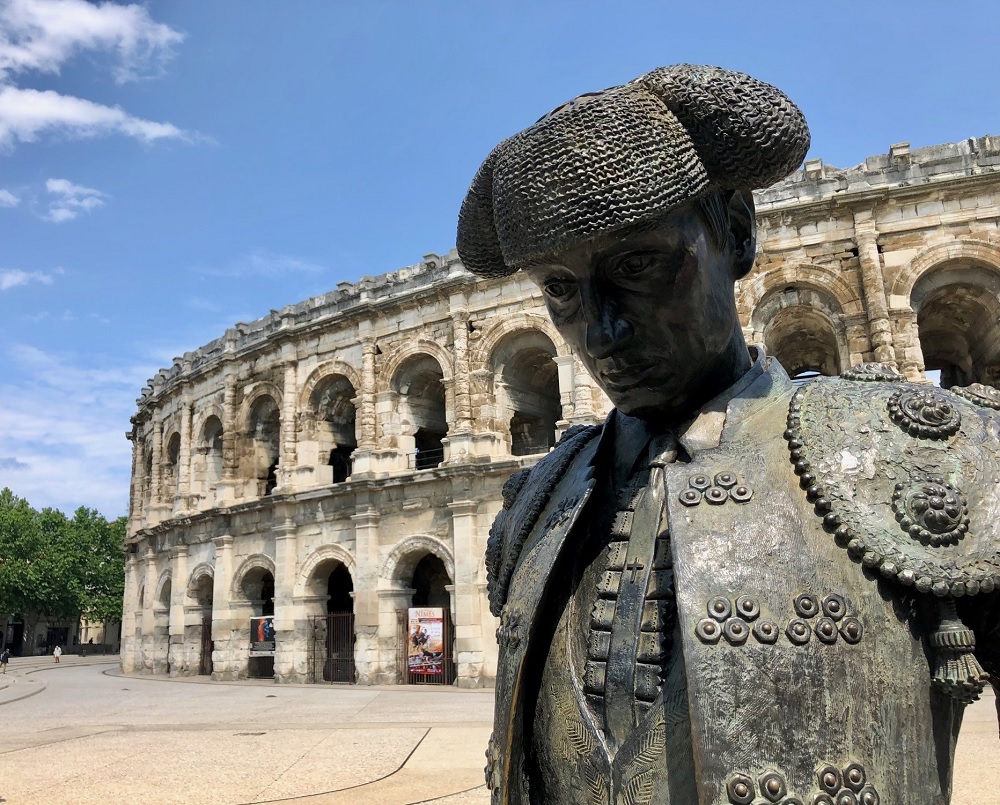
6. Paris – Arènes de Lutèce (Luticia’s Amphitheater)
Tucked away in the heart of Paris’s Latin Quarter is Lutetia’s Amphitheater. This Roman amphitheater dates back to the 1st century AD and once hosted gladiator battles, theatrical performances, orators, circuses, and public gatherings. Though partially destroyed, the remaining structure still shows the grandeur of Roman architecture, with its curved seating and open arena.
The nearest metro stop is Metro station Place Monge. Stepping from the street into the amphitheater feels like uncovering a secret. A small, unassuming passageway off Rue Monge leads you into a surprisingly spacious and tranquil spot. Best of all, entry is free – perfect for those visiting the fairly expensive city of Paris on a budget. For an unforgettable afternoon, pair your visit with a stop at Au P’tit Grec, a beloved street creperie on nearby Rue Mouffetard. Their savory crêpes are delicious and budget-friendly, but word to the wise: this spot is often cash only.
Daylight hours are the best time to explore, with afternoons offering a relaxing atmosphere for lounging or imagining the amphitheater’s past splendor. When visiting, consider staying in the charming Paris Art Hotel Quartier Latin by Malone, just a 6-minute walk away. This tastefully decorated hotel offers modern amenities and easy access to the Latin Quarter’s highlights.
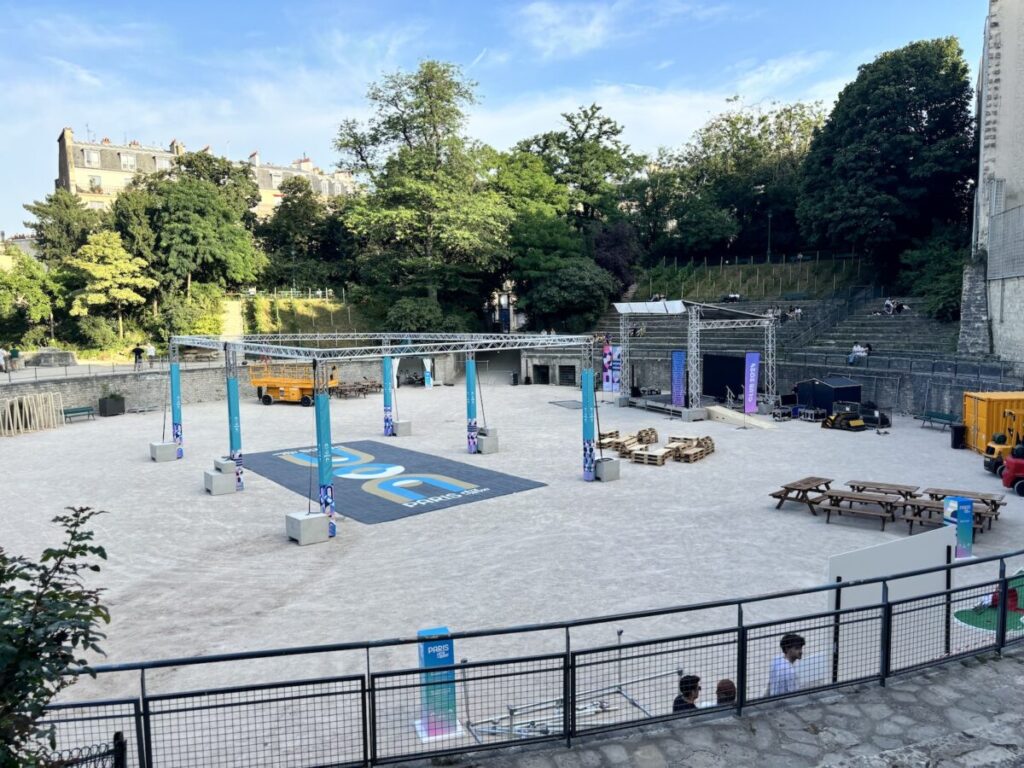
Top Roman Ruins in Europe: Germany
7. Trier – Porta Nigra and Imperial Baths
Germany isn’t often the place that you’d associate with Roman ruins, but Trier in the western part of the country has an incredibly well preserved example. The Porta Nigra is located in the heart of the historic district, and this ruin was once one of 4 gates that walled in the original Roman city. The “Black Gate” is the only one left remaining today. Oddly enough, the abandoned gate has been home to a hermit, a church, and a monastery over the years. The Porta Nigra is part of an UNESCO Heritage Site alongside 7 other churches and museums in the city.
The best time to visit is early in the day as soon as the site opens (usually around 9 AM). There are lower crowds at this point, which will allow you time to linger as you explore the layered architecture and many stone carvings. As part of your €4 adult admission, you can visit all 3 floors, though just the first is wheelchair accessible. A guided tour is a great way to learn more about Porta Nigra and Trier’s history.
If you want to stay as close as possible to the site, book a room at the modern, 4-star Mercure Hotel Trier Porta Nigra, which is directly across Porta-Nigra-Platz from the Roman ruin. The hotel is so close that you can have an uninterrupted view of the ruins from the hotel’s dining area and many of its guest rooms!
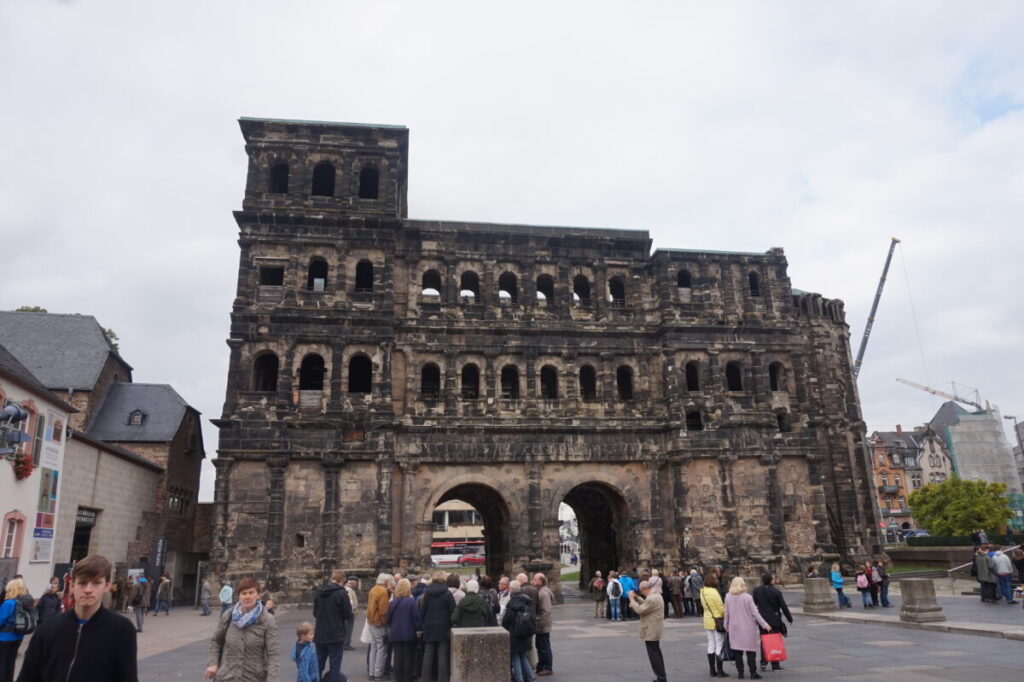
Top Roman Ruins in Europe: Italy
8. Ostia Antica – Roman Ruins a Stone’s Throw from Rome
If you love Roman history, you must visit Ostia Antica. This ancient port city, just 30 minutes from Rome, offers remarkably preserved Roman ruins. Walk along cobbled streets lined with ancient baths, temples, taverns, and even a theater. The mosaics and frescoes give a vivid glimpse into daily Roman life. Ostia Antica isn’t as crowded as Pompeii, making it a fantastic alternative. With its fascinating history and stunning ruins, it’s a must-see for any history enthusiast.
Ostia Antica is easy to reach. Take the Metromare train from Porta San Paolo station in Rome and get off at Ostia Antica. From there, it’s a 10-minute walk to the archaeological site. Entrance costs €18 for adults, and it’s free on the first Sunday of each month. Arrive early to beat the crowds and bring water—shade is limited. For a richer experience consider booking a guided tour in advance.
The best time to visit Ostia Antica is spring or autumn. The weather is mild, and the site is quieter. Summer can be unbearably hot, so plan accordingly. Stay nearby for a relaxed visit. The charming Fly Decó Hotel in Ostia Lido is a great choice. This cozy hotel offers comfortable rooms, excellent service, and easy access both to the ruins and to the beach. It’s perfect if you are looking for a peaceful base near Rome.
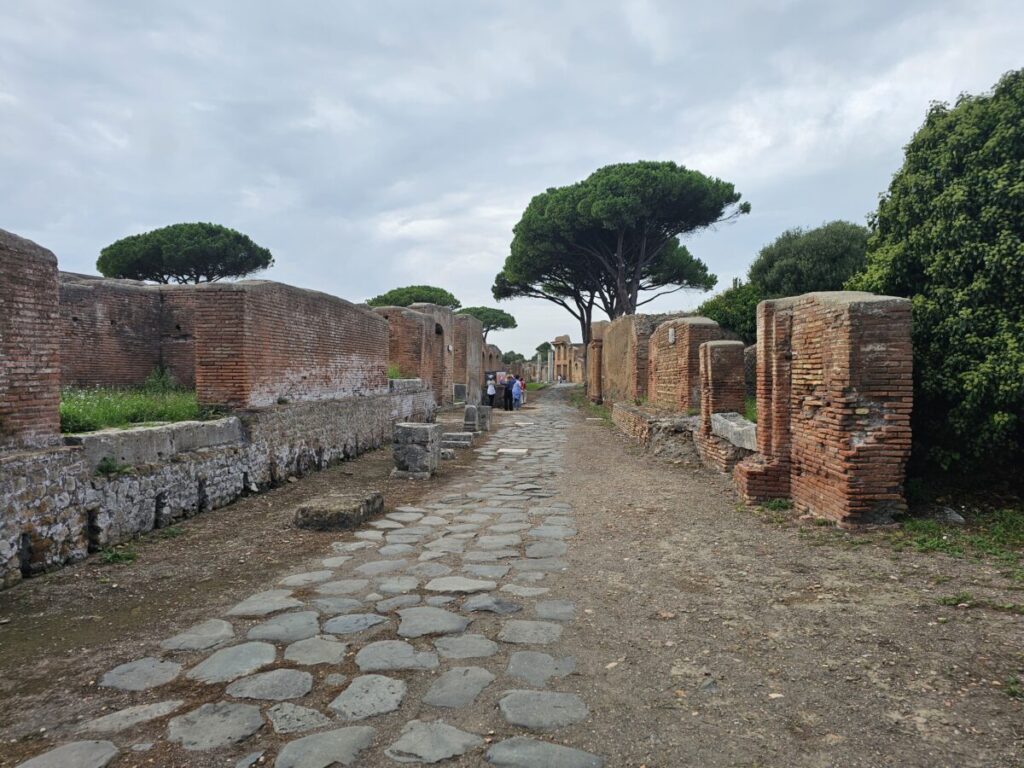
9. Pompeii – The Ancient City Preserved by Ash
Pompeii is a ruined Roman city that was buried in the ash and rocks from the eruption of the nearby Mount Vesuvius in 79 AD. It’s near to the city of Naples and easily accessible via train from the city centre. It’s an incredible sight as it is so well-preserved and gives you a real feel for life during Roman times.
Book a two-hour guided tour to find out more about each building and what it was used for, or you can pick up an audio guide and wander around the ruins yourself. Entry fee is €22 for one day which is reduced to just €2 for anyone aged between 18 and 25.
The best time to visit Pompeii is outside of the summer season, to avoid it being too crowded. During April and May, you should get plenty of spring sunshine and be able to enjoy a relaxed walk around the ruins.
You can stay nearby in Naples, which makes an excellent base for visiting not only Pompeii but the Herculaneum ruins and the Amalfi Coast too. The BW Signature Collection Hotel Paradiso is located in the Posillipo area of the city and is a wonderful mix of modern and traditional. It has incredible views over Napoli and Mount Vesuvius.
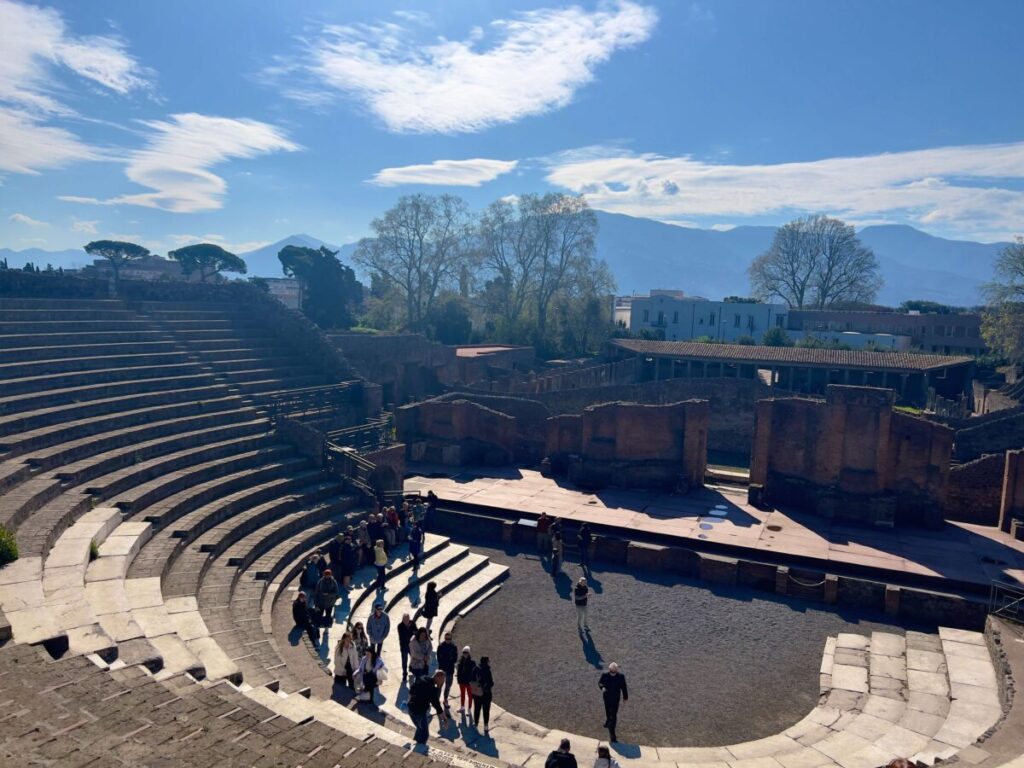
10. Rome – Colosseum, the Roman Forum, and Palatine Hill
When in Rome, set aside plenty of time to the many Roman ruins in and around the city. Three of the most visited sights are the Colosseum, Roman, Forum, and Palatine Hill. The Colosseum is the largest ancient amphitheater in the world, built in 70–80 AD. This architectural marvel hosted gladiatorial contests, public spectacles, and even mock sea battles, symbolizing the grandeur of the Roman Empire.
Adjacent to the Colosseum, the Roman Forum was the epicenter of Roman political, religious, and social life. Its ruins include the Temple of Saturn, the Arch of Titus, and the Senate House. Overlooking the Forum, the Palatine Hill is the legendary birthplace of Rome, where Romulus is said to have founded the city. It also served as the residential area for emperors, featuring opulent palaces and gardens.
All 3 attractions are close together, easily accessible by the metro’s Colosseo stop. A 24 hour combo ticket is currently €18, providing access to these 3 sights. Take a tour of the 3 attractions to make the most of your experience. Tip: the Colosseum can only be entered at the booked time. Book tickets online in advance to ensure that you can skip the ticket lines.
These attractions can be quite crowded. If possible, consider a visit to Rome in the off season, from late Fall to early Spring, for the most manageable crowds. For absolute convenience when exploring these 3 destinations, stay at the Hotel Forum Rome, with views overlooking the Roman Forum.
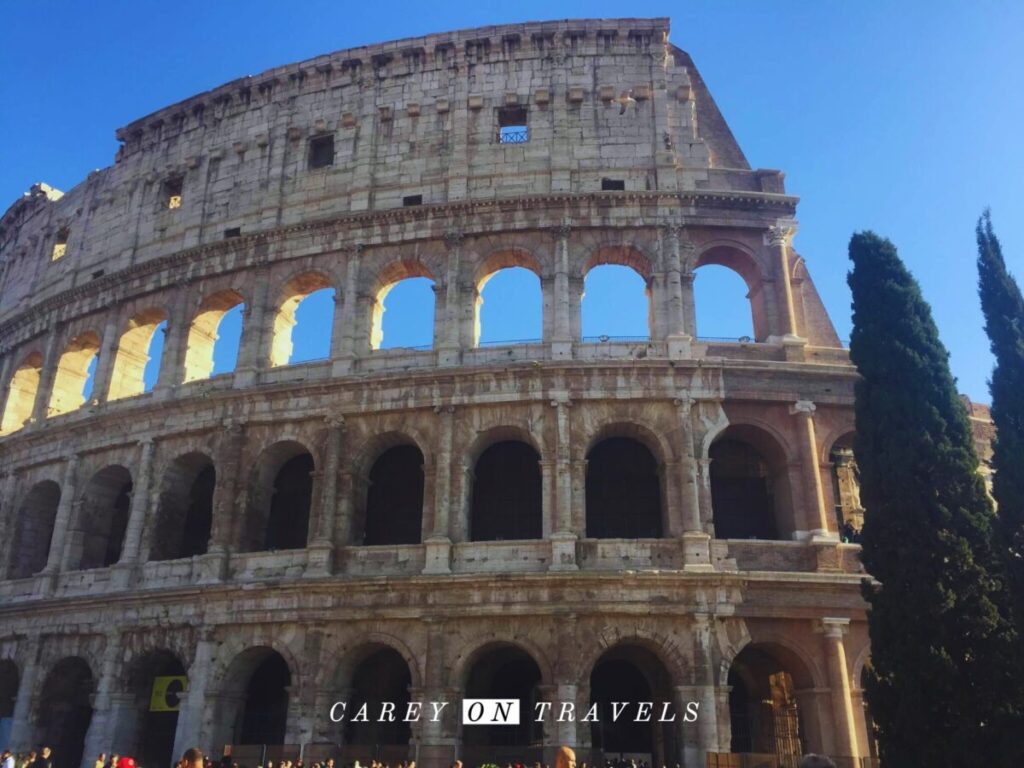
11. Siracusa (Syracuse) – Neapolis Archaeological Park
The Neapolis Archaeological Park is located in Siracusa, on the southeastern shore of Sicily. The park houses the impressive Greek Theater, Roman Amphitheater, and the Altar of Hieron. It’s a blend of Greek and Roman heritage on Sicily’s eastern coast. Whether you visit Siracusa on a day trip or use this as your base for exploring Eastern Sicily, it’s definitely worth a stop at the Neapolis Archaeological Park.
For those exploring the historic center of Ortigia, accessing the park is quite easy. Catch a ride on the Sd’A Trasporti minibus from the west side of the main bridge into Ortigia. Alternatively, walk 30 minutes or rent a bike and enjoy the ride over to the park. The entrance fee is currently €16.50, though free for those under 18 and on the 1st Sunday of the month. Taking a small group tour of the park is one of the best ways to make the most of your park experience.
Spring and Fall are ideal times to visit for cooler weather and fewer crowds. If you visit during the summer, try to time your park stay for just after opening in the morning. For a luxury stay close to the ruins, consider a stay at the Ortea Palace Luxury Hotel. This converted art nouveau post office offers an indoor pool, spa, and a restaurant, all in close proximity to Apollo’s Temple and other Ortigia’s highlights. If you enjoy Greek ruins as well, don’t miss a day trip to the temples of Agrigento.
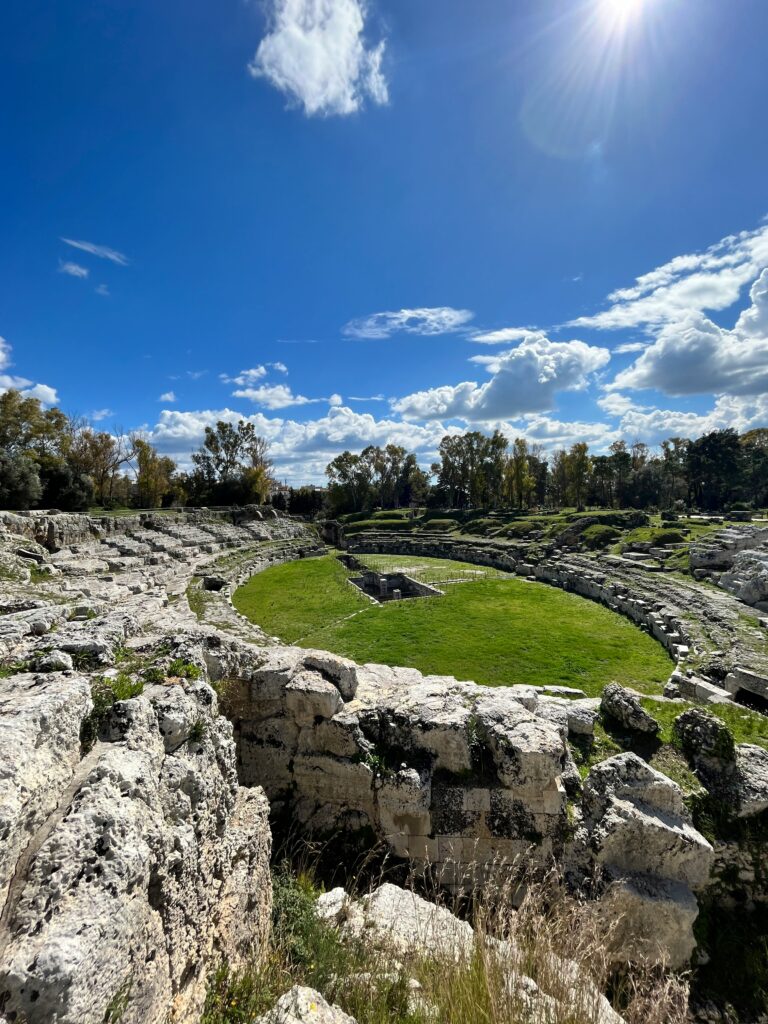
Top Roman Ruins in Europe: Portugal
12. Conimbriga – Ancient Roman City
Conimbriga is one of Portugal’s largest and best-preserved Roman cities, known for its complex mosaics and well-preserved baths. Dating back to the 2nd century BC, it includes a residential area, forum, and aqueduct.
Most access the ruins via the town of Coimbra, which is a roughly 2 hour train ride from Lisbon. If you are driving, it’s a quick 15 km drive from Coimbra. While there is a public bus, it runs quite infrequently. Alternatively, it may be best to take a tour to the ruins or a taxi. The €4.50 entry fee to the sight includes access to the ruins and to the small museum. We’d suggest visiting the museum first to learn more about the history, then visit the ruins themselves. Allocate a few hours to explore the detailed mosaics and remnants of the thermal baths.
You can visit the ruins any time of year; to avoid the heat of the summer and any crowds, try visiting in spring or fall. For those with a car who would like to stay close to the ruins, try the recently renovated palace hotel, Conimbriga Hotel do Paço in Condeixa-a-Nova.
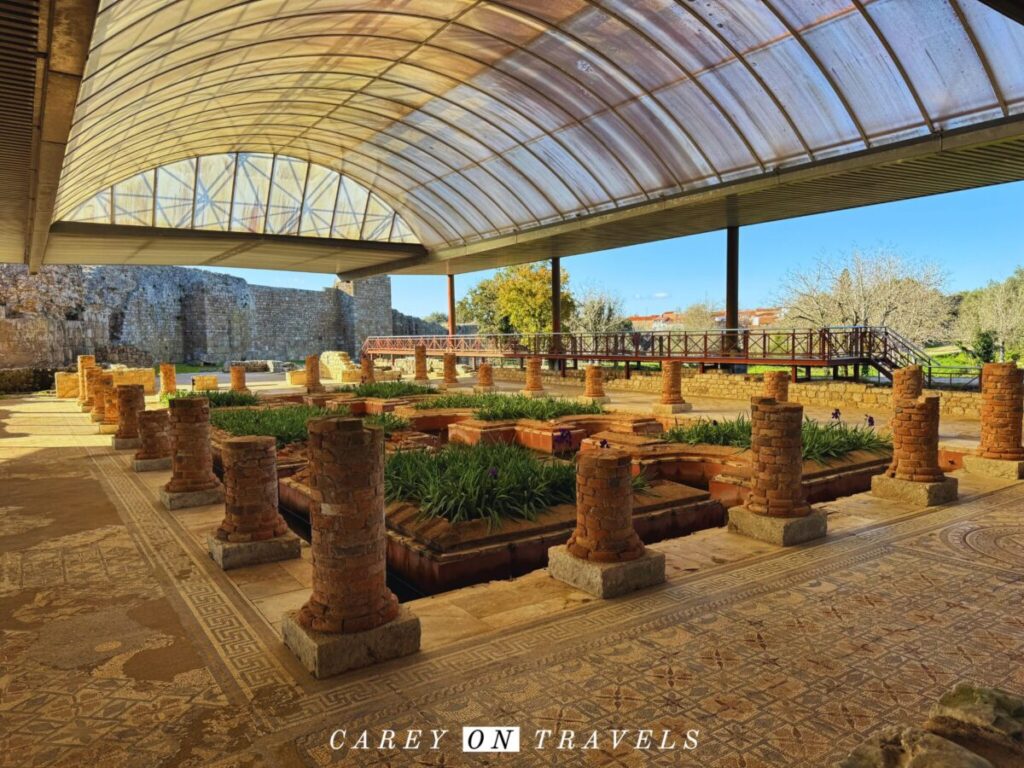
13. Estoi – Roman Ruins of Milreu
The Algarve, Portugal’s southern sun-soaked region is not typically associated with history and Roman ruins. However, if you know where to look, you’ll find multiple places that display impressive evidence of the Roman occupation of Portugal.
One of the best locations in the Algarve is Milreu’s Roman Ruins, on the outskirts of the village of Estoi. Dating back to the 1st century AD, this archaeological site was once a luxurious villa complex that evolved into a significant agricultural estate. It’s an impressive site where the importance of local maritime life is fully on display. You’ll find intricate mosaics depicting marine life, as well as the ruins of a temple, baths, and various outbuildings. There’s also a small but excellently curated museum holding artifacts found at the villa and from nearby areas.
To reach the Milreu ruins, travellers can drive approximately 9 kilometres north from Faro via the N2 road, with parking available near the entrance. For those relying on public transportation, buses from Faro to Estoi are also available. The ruins are just a short walk from the village centre.
Entry to the site is €2 and tickets include entry to a small but well researched museum, tickets can be purchased at the entrance. The ruins are open Tuesday to Sunday from 9:00 AM to 5:00 PM. It’s usually a very quiet site that’s suitable for visiting anytime of the year.
For a truly luxurious stay nearby, you can stay at Estoi Palace, an immaculately restored 18th Century Romanticist Palace. It is a one-of-a-kind place, and the ultimate experience in this rural part of the Algarve. Even if you don’t plan on staying overnight it is well worth a visit to explore the palace and its terraced gardens.
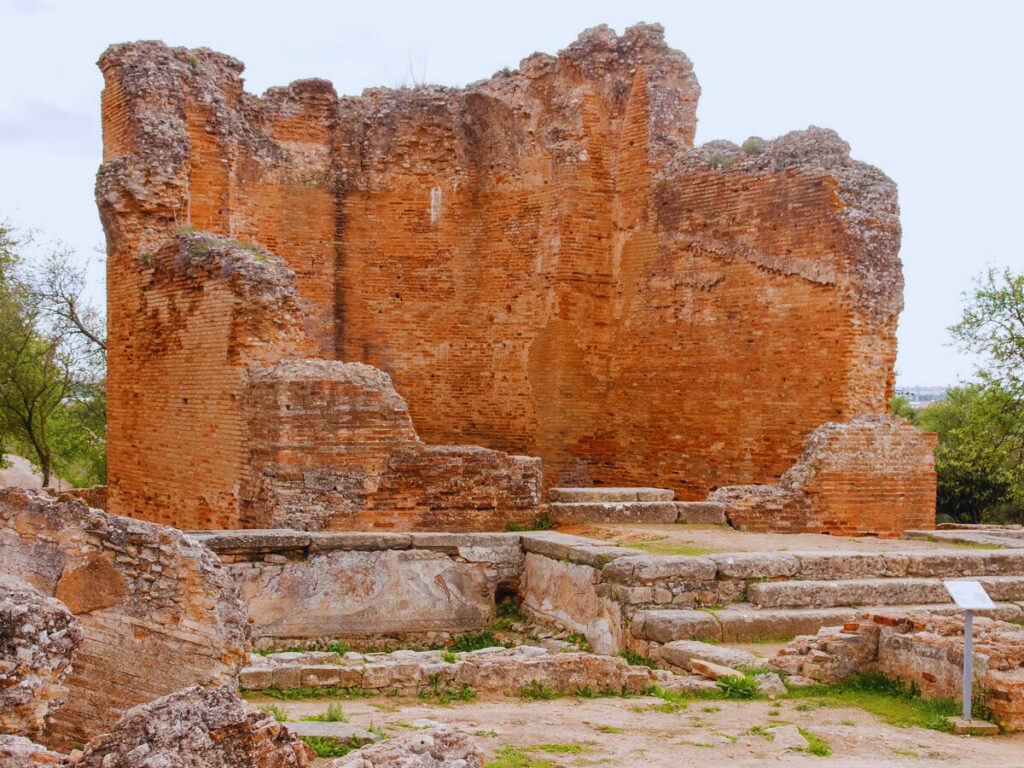
14. Évora – Roman Temple
Évora is known for its medieval streets, university, and the Roman Temple (also known as the Temple of Diana). This is one of Portugal’s best-preserved Roman ruins, dating back to the 1st century AD and is believed to have been dedicated to Emperor Augustus.
Located in the town center of Évora, the temple is easily accessible on foot if you’re staying in town. Consider taking a tour to learn more about the history of these Roman ruins and the historic center of Évora. From Lisbon, take a train or bus to Évora (about 1.5–2 hours). Entry to the site is free and is accessible 24 hours a day. It can be visited anytime, though avoiding summer time will result in fewer crowds.
For a luxurious stay just across from the temple itself, you can stay at the Pousada Convento de Évora (also known as Pousado dos Lois). The hotel is in a beautifully restored 16th-century convent right in the historical heart of Évora and close to the university. Guests can enjoy a serene atmosphere, elegant rooms, an exquisite courtyard, and a pool. Walk outside the front door for views of the temple below. Whether you enjoy staying right in the historical heart or in the surrounding areas, there is no shortage of unique places to stay in Évora.
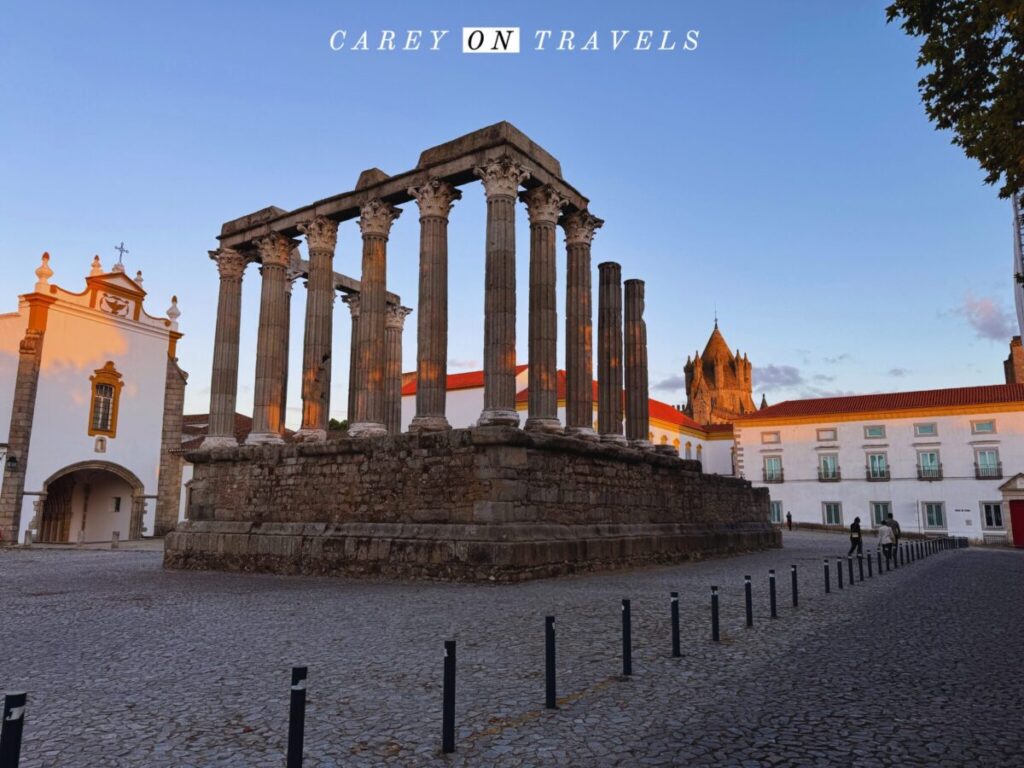
Top Roman Ruins in Europe: Spain
15. Málaga – Roman Theater and Alcazaba
Rediscovered in 1951, the Málaga Roman Theater is one of Spain’s most fascinating historical sites. It’s a beautifully preserved theater dating back to the 1st century AD during Emperor Augustus’ reign. It features a seating area (cavea), orchestra, and stage, which blend Roman engineering and Greek influence.
Since these Roman ruins are located right in the heart of the city center and just a short stroll from the bustling port, you’ll likely stumble upon it by accident. On top of that, it’s build on the hill leading up to the Alcazaba, so you can’t miss it. If you still want to use public transport, buses such as lines 1, 3, 11, and 34 will take you close to the site. The nearest train station is Málaga Centro-Alameda. Best of all, entrance to the ruins is free! An optional guided tour helps you to immerse yourself in the history of the ruins.
The best time to visit is during Christmas because Málaga’s festive lights and decorations are among the best in Europe. Also, the city is less crowded then, but the weather is still sunny. For accommodations, consider staying at Stop Hostel, located just outside the city center. It’s budget-friendly, reachable on foot, and offers a comfortable base for exploring Málaga’s treasures.
Don’t forget your camera—the ruins are incredibly photogenic. If you’re lucky, you might even spot one of the famous cats lounging on the ancient stones!
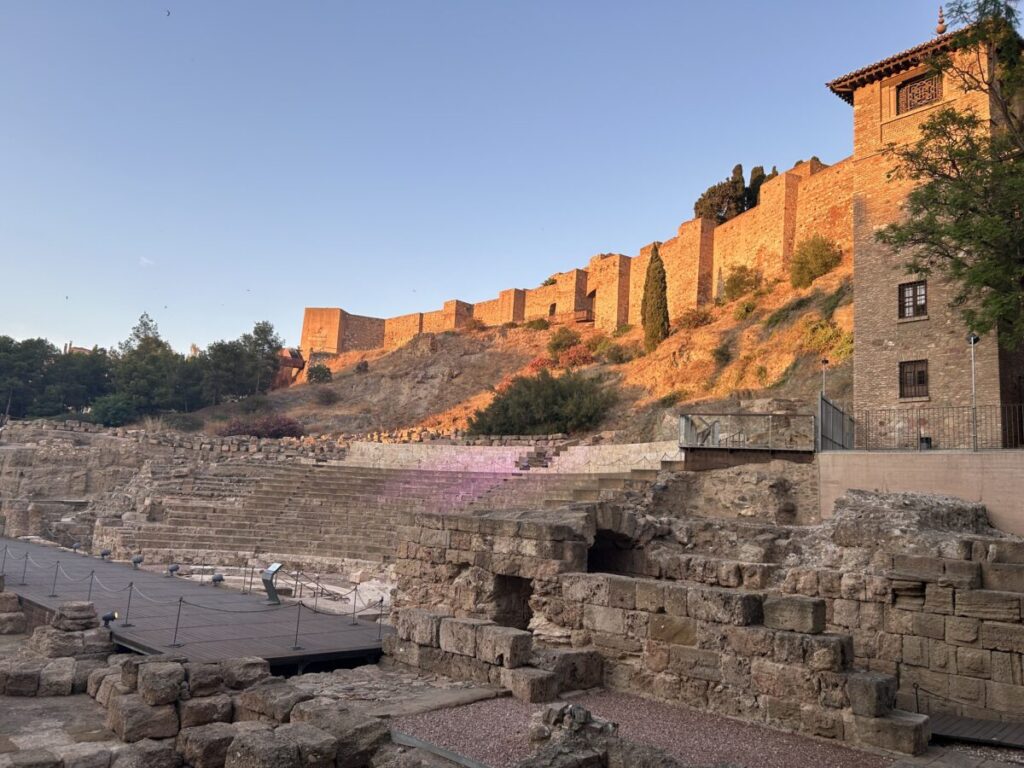
16. Mérida, Spain – The Roman Marvel of Spain
Mérida, in Spain’s Extremadura region, is a UNESCO World Heritage Site and a showcase of Roman grandeur. It was once the capital of the Roman province of Lusitania, which covered parts of modern-day Spain and Portugal. Mérida boasts some of Europe’s best-preserved ruins, with theaters, temples, bridges, aqueducts, and more, putting this high on the list of the Top 10 Roman Ruins in Spain.
Many of the Roman ruins can be seen by taking a walking tour through Mérida. One of the highlights is the Roman Theater, which still hosts performances during the annual Mérida Classical Theatre Festival. A few other highlights include a visit to the Roman Amphitheater, Temple of Diana, Roman Bridge, and Aqueduct of Los Milagros. Discovering all of the Roman Ruins in and around Mérida will take a day or more.
Mérida is easily accessible by train from Madrid, Seville, and Lisbon. The train station is centrally located, making the city easy to explore on foot. Spring and fall are the ideal times to visit, with pleasant weather perfect for exploring. Conversely, if you can time your trip during the Mérida Classical Theatre Festival, you’ll have an unforgettable experience. In that case, plan to visit the ruins in the morning or late afternoon and evening to avoid the heat. Stay in the heart of town at the Parador de Mérida, a converted convent, blending history with comfort, just a short walk from the ruins.
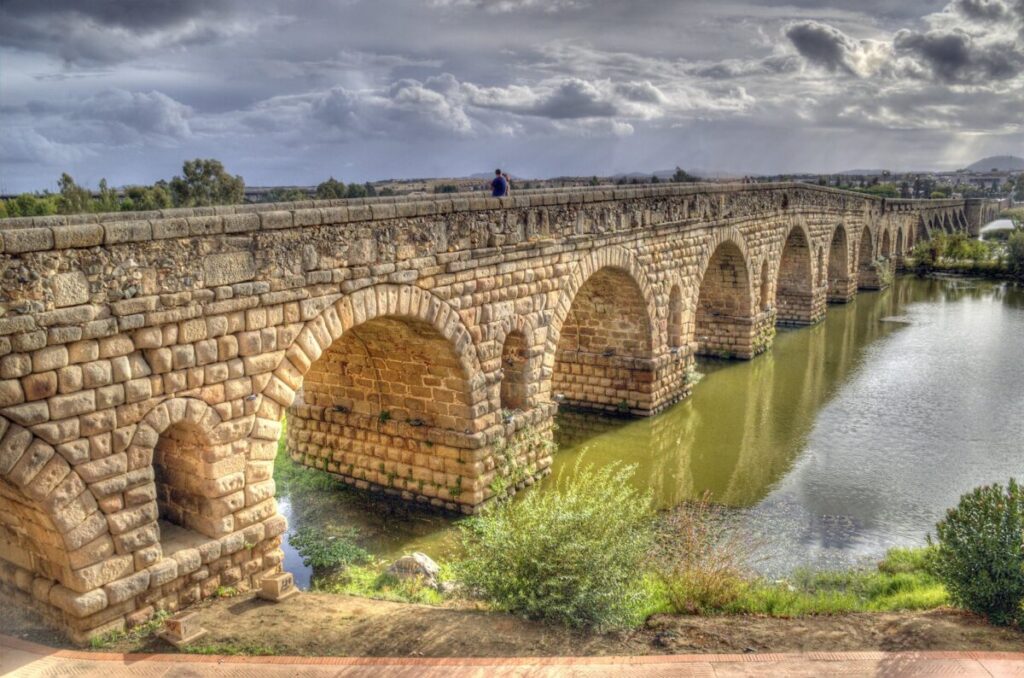
17. Tarragona – Roman Amphitheatre and Aqueduct
Tarragona is designated as a UNESCO World Heritage Site thanks to the impressive Roman ruins scattered across the city. The city walls are the oldest Roman monument in Tarragona, dating back to the 3rd century BC. The well preserved Roman amphitheater is one of the most impressive sites, with its backdrop of the Mediterranean Sea making it even more special.
Head underneath the modern city to get a closer look at the remains of the Roman circus and climb the Torre del Pretori for fantastic views. Additionally, visit the temporary exhibits of the Tarragona Archaeological Museum and the Early Christian Museum and Necropolis. This requires a different ticket, which includes entry to the Roman Villa of Els Munts and Monumental Complex of Centcelles, both accessible by car outside of the city.
The best value option is to buy a joint ticket for €15, enabling you to visit 5 different sites: the Roman Walls walk, Amphitheatre, Circus, Forum, and Theatre. Most sites are closed on Mondays. Be sure to visit the Roman Ferreres Aqueduct (the Devil’s Bridge), which you can get to by bus or taxi from the city centre. It’s free to visit, and you can walk across the aqueduct and hike in the forest in the area.
The best times to visit are spring and early autumn, with the warm weather and relatively fewer tourists compared to the summer months. The Tarraco Viva festival at the end of May will be busy, but allows you to see demonstrations of Roman history brought to life through historical reenactments, performances, and guided tours throughout Tarragona. The H10 Imperial Tarraco 4* Sup is a lovely 4* hotel with views of the city, ruins or beach.
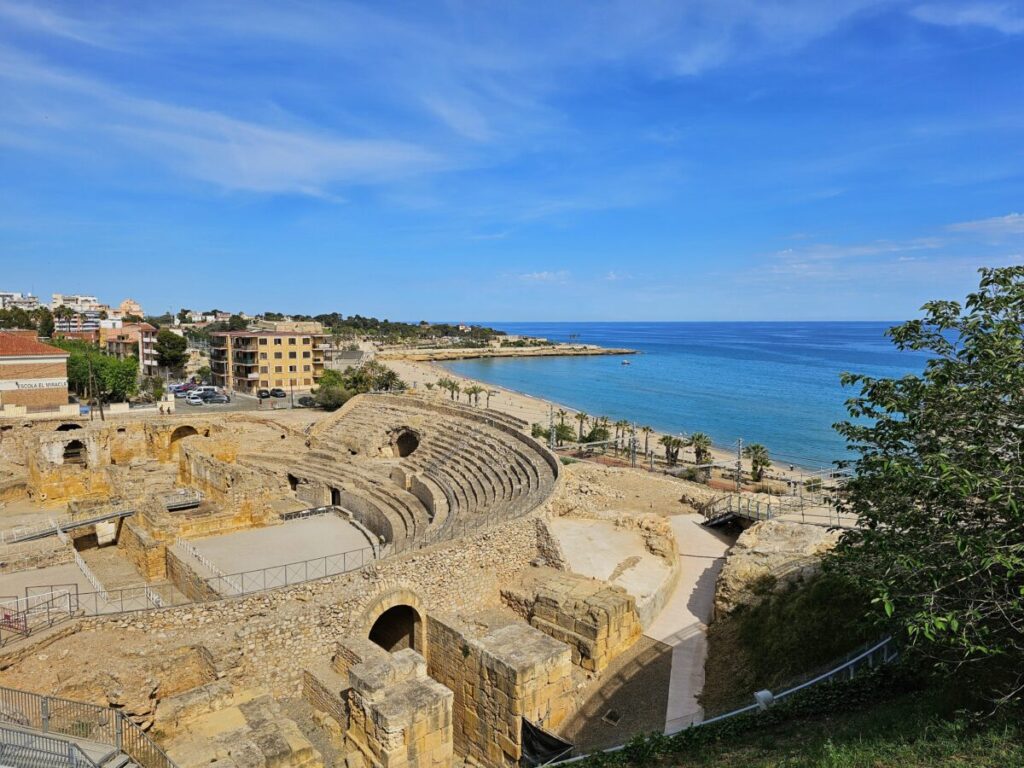
Wrap-Up
Exploring the Roman ruins of Europe is like stepping into the pages of history, where ancient civilizations come to life through grand amphitheaters, intricate mosaics, and towering temples. Each site tells its own unique story, reflecting the architectural prowess and cultural richness of the Roman Empire.
If you enjoyed this post, pin it for later!


Travel Resources
We recommend booking through our preferred travel booking sites below.
| Air Travel | SkyScanner |
| Lodging | Booking.com, VRBO.com, Expedia.com, Hostelworld |
| Tours and Activities | Viator.com, GetYourGuide.com, TakeWalks.com |
| Car rentals | Discovercars.com |
| Travel insurance | Squaremouth |
| Bike and scooter rentals | BikeBookings.com |
| Train tickets | Trainline, RailEurope |
| Bus tickets | Flixbus, Busbud |

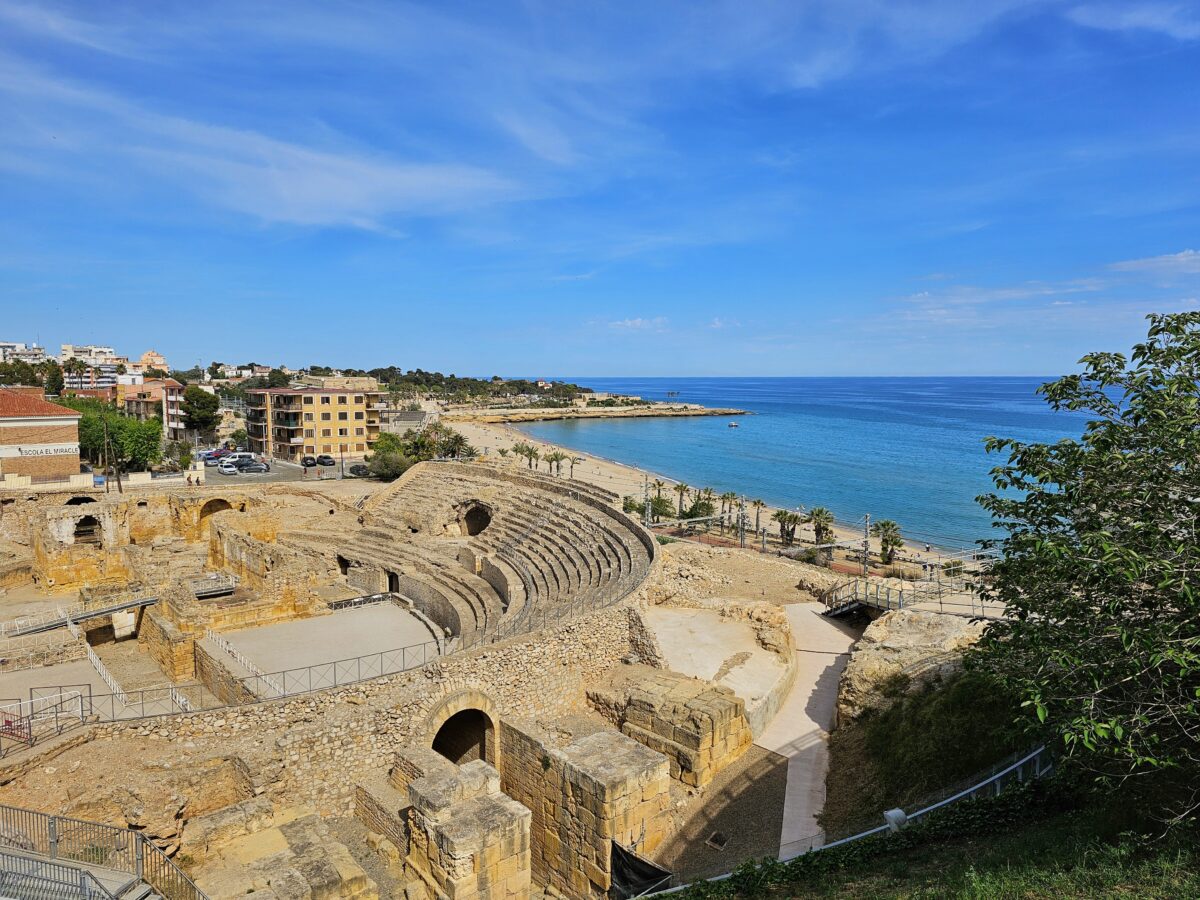





This is a great list! I’m all about finding the history without finding the crowds 😉
We are too!
[…] seconds agoAdd comment Share this article FacebookRedditPinterestEmail Next article Must-Visit Roman Ruins in Europe Home » Blog » UNESCO » Discovering Mérida, Spain: Roman Ruins and Timeless […]
Europe’s Roman ruins are truly captivating—each site feels like stepping back in time. It’s amazing how these ancient structures still tell such vivid stories today.
Great list, including some well off the beaten track spots. I also would suggest Herculaneum and the Villa of Oplontis (Pompeji Complex) as som ereally educational and impressive Roman ruins, and look at Turkiye, which has hundreds if not THousands of really impressive Roman ruins. Empty amphiteatres galore.
Thank you for the suggestions. There are so many more that could be included–while we’ve visited a few of your suggestions, we haven’t visited those in Turkey yet.
I’ve been lucky enough to visit a few of these, but had no idea there were so many options throughout Europe to see Roman ruins. Fascinating!
I had thought to create a more comprehensive list, but these are some great highlights to start with.
Wow! What a unique article! Thank you for the information.
Thank you for the feedback!
Great post. I have visited some of these Roman ruins and they are fascinating. Hope to see the ones in Conimbriga, Portugal. The mosaics look beautiful.
Thanks, hope you have a chance to visit Conimbriga!
I am always fascinated to see how far widespread the Roman ruins are. It gives you a real appreciation for what it took for that expansion at that time. And it is always surprising at how well preserved some of these are. I must admit I am drawn to the ancient amphitheaters!
I really enjoy the ancient amphitheaters too (and the temples).
I have done several of these sites visits this year, including Sicily. I was awe struck, I also recommend visiting the Roman museum in Cirencester, UK to learn more about the Roman’s’ colonization of the British isles. Your post is so helpful!
Thank you for the recommendation–looks like the museum is an easy day trip from Oxford, which we visit fairly frequently.
We love visiting Roman ruins wherever we go. I’ve only been to the ones in Rome from your list though, so I’ve still got alot to visit.
Hope this will inspire some more visits!
Loved this blog. I have enjoyed several of the Roman ruins in your blog and as I started to read i was hoping that Ostia Antica was included. I visited the site in a trip to Rome. In fact went there diect from airport before heading in to Rome. it’s was great to wander around looking at the ancient sites and learned so alot.
These are so close to FCO–great suggestion on stopping there before heading into town.
Such a useful post! Great idea and lots of well laid out info. I will definitely use this…headed back to France in the Spring and there are some we have not seen. Thanks for all your work on this.
Thank you for the feedback!
Exploring Roman ruins across Europe is like stepping into a time machine! I am mostly familiar with Roman ruins in Croatia (we have a lot), and Rome (of course!), but thank you for sharing such a comprehensive guide!
Thanks for the feedback. There are so many across Europe, we’re always visiting new ones.
[…] ago37 comments Share this article FacebookXRedditPinterestEmail Previous article Must-Visit Roman Ruins in Europe Next article Portugal UNESCO Heritage Sites: Exploring Elvas Home » Blog » UNESCO » […]
[…] Amphitheatre, one of the top Roman ruins in Europe, where gladiators once […]